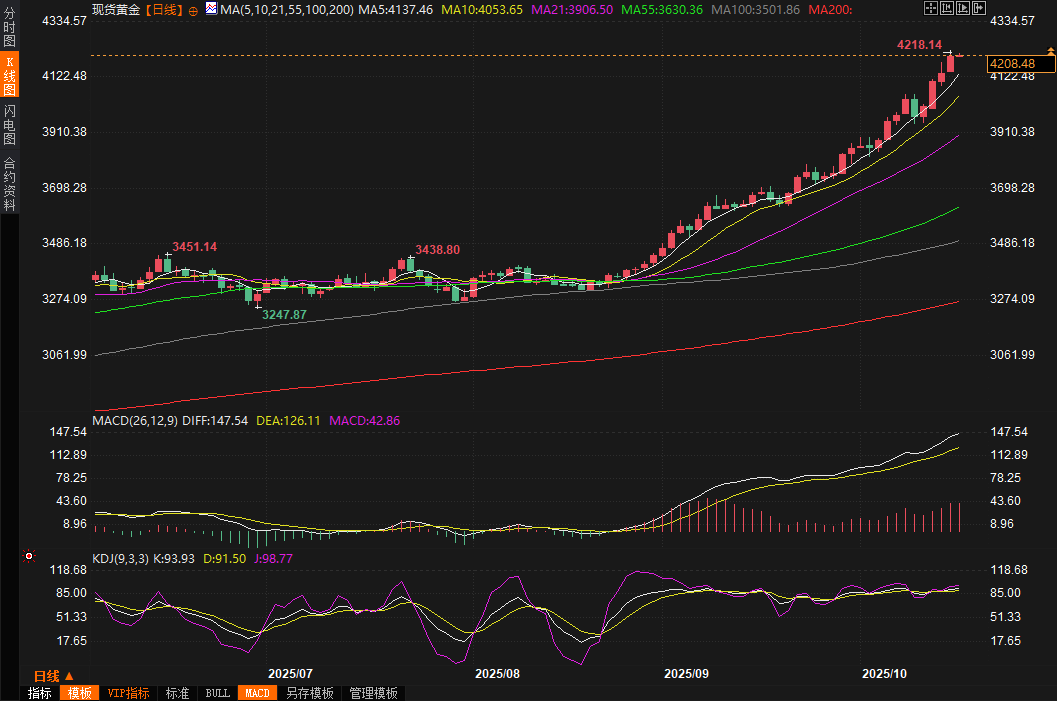Gold trading reminder: Bulls are on a roll! Safe-haven sentiment and the Fed's dovish stance have pushed gold prices up for four consecutive days, pushing past the 4,200 mark.
2025-10-16 07:50:27

Markets expect the Fed to cut interest rates twice this year
The surge in gold prices wasn't a sudden event, but rather the result of a confluence of favorable factors. Rising expectations of interest rate cuts have become the core driver of gold's gains. Federal Reserve Chairman Powell, in a recent speech, explicitly stated that the US labor market remains "depressed with low hiring and low employment." These dovish comments directly led to a decline in the US dollar index, significantly increasing gold's appeal as a hedge.
Traders are almost unanimously betting that the Federal Reserve will cut interest rates by 25 basis points at its meeting at the end of October, and the probability of another rate cut in December is as high as 100%. In a low-interest rate environment, the advantages of gold, a non-interest-bearing asset, are particularly prominent because it can effectively protect against inflation and uncertainty.
The Fed's policy moves have always been a bellwether for the gold market, and Powell's speech undoubtedly reinforced market expectations of rate cuts. He emphasized that despite the lack of official economic data due to the government shutdown, the Fed still has sufficient information to assess the economic outlook and has not ruled out the possibility of further rate cuts.
This view was reinforced by the Federal Reserve's Beige Book report, which showed little recent change in U.S. economic activity, with employment broadly stable, but with growing signs of weakness, including rising layoffs and spending cuts by middle- and low-income households. This report, which has been particularly valuable during the government shutdown because it provides more timely grassroots feedback than official data, has shown.
The Beige Book reports that businesses in several Federal Reserve districts reduced their workforces through layoffs and natural attrition, citing factors including weak demand, economic uncertainty, and increased investment in artificial intelligence. Meanwhile, changes in immigration policy have led to tight labor supply in the hospitality, agriculture, construction, and manufacturing sectors, further exacerbating labor market pressures.
In terms of consumption, overall spending has declined slightly, especially in the retail sector. Middle- and low-income families are more sensitive to inflation and even rely on food distribution points and “buy now, pay later” services.
Despite disagreements among Federal Reserve officials, the market has fully priced in an October rate cut. Boston Fed President Collins and Governor Milan have also expressed support for two more rate cuts this year. This dovish tone has not only depressed US Treasury yields but has also indirectly increased the appeal of gold. The 10-year Treasury yield briefly hit a multi-week low before fluctuating upward, but the overall trend remains downward, providing a solid foundation for gold's low-interest rate environment.
Signs of weakness in U.S. economic data
Gold's safe-haven appeal has been further amplified by signs of weakness in the U.S. economy. The 15-day government shutdown is costing about $15 billion a day in lost economic output, impacting the release of key data such as inflation and retail sales.
While the New York Fed's Empire State Manufacturing Index rose to 10.7, exceeding expectations, overall economic activity remained largely unchanged. The Beige Book report, which highlighted cooling consumption and rising layoffs, drew attention. Several Fed districts reported that tariffs have increased input costs, and while the degree of pass-through to final prices has varied, this has already boosted inflation expectations. The word "tariff" was mentioned 64 times in the report, highlighting its impact on the economy.
The divergence in consumption patterns is particularly pronounced, with high-income groups experiencing increased spending while middle- and lower-income households are experiencing a "middle-class recession," with restaurant diners even skipping desserts and alcoholic beverages to save money. Rising risks in the labor market have justified the Federal Reserve's interest rate cuts, and Wall Street's unemployment claims estimates are also showing an upward trend.
These grassroots feedbacks amidst this data vacuum have led investors to favor gold as a hedge. The gap between the two-year and 10-year Treasury yield curve is reported at 53.8 basis points, a positive indicator of economic expectations and reflecting market caution regarding recession risks. The decline in TIPS break-even yields also suggests future inflation expectations of around 2.3%, further reinforcing gold's anti-inflationary properties.
Escalating international trade tensions
The resurgence of international trade frictions has become a key catalyst for gold prices to break new highs. US President Trump's remarks that he is considering ending some trade relations with China quickly ignited market anxiety.
Senior U.S. officials, including Treasury Secretary Jeffrey Bessant and Trade Representative Greer, have publicly criticized China's move to expand rare earth export controls, saying it threatens global supply chains and accusing China of reneging on a trade agreement reached over the past six months.
Although U.S. officials stressed they had no intention of escalating the conflict, Trump's tariff threats last week still kept markets on edge.
China's Ministry of Commerce responded sharply, saying that the US restrictive measures seriously damaged China's interests and accused the US of "hypocrisy."
This tense situation directly weakened market sentiment and led to a decline in the US dollar. The US dollar index has fallen for two consecutive trading days to 98.65, a low in nearly a week, which further provided room for gold to rise.
Analyst Adam Button observed that while the market has shown immunity to trade news and believes that China and the United States will ultimately find a way forward, the inflammatory nature of the headlines remains. Trade uncertainty is impacting not only the foreign exchange market but also global supply chains, prompting investors to turn to gold as a buffer. It is important to note that this friction is not an isolated incident but is embedded in a broader geopolitical framework, including the global trend towards de-dollarization, which makes gold's safe-haven role indispensable.
Heightened geopolitical tensions have further amplified safe-haven demand. Investors are diversifying their investments in gold to hedge against stock market risks, a strategy that is particularly sensible in the current environment.
Analyst Fawad Razaqzada bluntly stated that gold's rise "doesn't seem to want to stop" and predicted that it would soon hit the $5,000 mark. This is not just an optimistic guess, but a rational judgment based on multiple factors such as central bank buying, de-dollarization, and strong ETF inflows since the beginning of this year.
Summary and Outlook
In short, gold's feat of breaking through $4,200 is the result of a combination of interest rate cut expectations, geopolitical tensions, and economic weakness. This safe-haven storm has not only reshaped the global financial landscape but also provided valuable opportunities for investors.
Looking ahead, with the Federal Reserve likely to continue cutting interest rates and ongoing international trade frictions, gold's march toward $5,000 will become increasingly resolute. However, the market should also be wary of the risk of short-term overheating. If trade frictions show signs of easing or the Federal Reserve sends hawkish signals, gold prices could face downward pressure. However, in the long term, amidst the growing global economic uncertainty, gold's role as a safe haven remains irreplaceable.

(Spot gold daily chart, source: Yihuitong)
At 07:49 Beijing time, spot gold was trading at $4209.22 per ounce.
- Risk Warning and Disclaimer
- The market involves risk, and trading may not be suitable for all investors. This article is for reference only and does not constitute personal investment advice, nor does it take into account certain users’ specific investment objectives, financial situation, or other needs. Any investment decisions made based on this information are at your own risk.





















